The Subjective Facial Aesthetics
The soft tissue profile is essential for facial esthetics and treatment planning in orthodontics. It highly affects the treatment to achieve alignment of teeth based on the patient’s perceived harmonious lip position. The preference in lip profile varies according to race or ethnicity as primarily a result of subjective psychosocial views. The Caucasians and Arabs prefer an orthognathic profile. The Chinese and Japanese prefer either an orthognathic or more retrusive profile. While the common profile noted among the Malay and Indians is a bimaxillary protrusive.
Measuring The Lip Profile with S-line and E-line
The two widely used base lines in orthodontic evaluation are the S-Line and E-Line. In order to determine the anteroposterior location of the lower and upper lips and the aesthetic consistency of the profile, several analyses have been used. Steiner defined the S-line as an invisible line running from the soft tissue pogonion to the midpoint of the S-curve line of subnasale and pronasale. For a balanced profile, the base line must be touched by the lips. A retrusive profile may be seen behind the line and the protrusive position lies in front of the line. Ricketts utilised the E-line as being a line from the pronasale to the pogonion. The harmonious profile according to the E-line should show both lips standing behind, 2mm for the lower and 3mm for the upper. A more anterior position is labelled convex, while a more posterior position is identified concave.
It should be noted that the shape of the nose and chin prominence are also major factors affecting the harmony of the patient’s overall profile. A small nose adds to the softening of the sharpness of the profile. The prominence of both the chin and nose contributes to a more concave profile.


For objective reasons, values are computed for orthodontic analysis through reference lines and points. The difference in location of points affects how the reference lines measure the lip position. Often, the line of choice depends on stability and consistency in relation to ethnic and racial anatomical and aesthetical norms.
References:
Al Taki A and Guidoum A (2014). Facial profile preferences, self-awareness and perception among groups of people in the United Arab Emirates. Journal of Orthodontic Science 3(2), 55-61.
Hui Theng Chong, Kim Wei Thea, Joseph Descallar, Yong Chen, Oyku Dalci, Ricky Wong, M. Ali Darendeliler (2014). Comparison of White and Chinese perception of esthetic Chinese lip position. Angle Orthod; 84 (2): 246–253. doi: https://doi.org/10.2319/031213-212.1
Mantzikos T (1998). Esthetic soft tissue profile preferences among the Japanese population. Am J Orthod Dentofacial Orthop 114, 1-7.
Mohammad HA, et al. (2011). Cephalometric evaluation for Malaysian Malay by Steiner Analysis. Scientific Research and Essays Vol. 6(3), pp. 627-634.
Moldez, MA et al. (2006). Linear and Angular Filipino Cephalometric Norms According to Age and Sex. Angle Orthodontist, Vol 76(5), 800-804.
Pandey S, Kapoor S, et al (2021). Evaluation of Lip Position in Esthetically Pleasing Profiles Using different reference lines: A photographic study. J of Indian Orthodontic Society 55(3), 261-269.
Perović T (2017). Class II/2 malocclusions and the face profile harmony. Med Sci Monit 23, 5589-5598.
Rahoojo A, Naz S, et al (2022). Soft tissue lip profile with Steiner (S) and Ricketts (E) Lip Analysis in Patient’s with Skeletal and Dental Class I Occlusion. Pakistan Journal of Medical and Health Sciences 16 (1), 786-788. https://doi.org/10.53350/pjmhs22161786
Zia B.et al (2017). Comparison of Pakistani and Caucasian Cephalometric values according to Steiner’s Analysis. Int J Dent Health Sci 2017; 4(2):279-283
